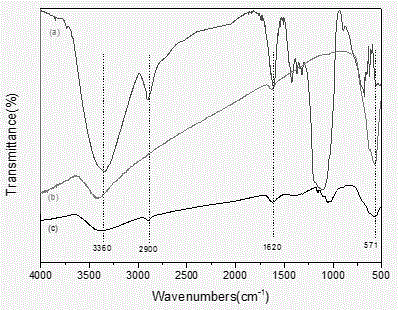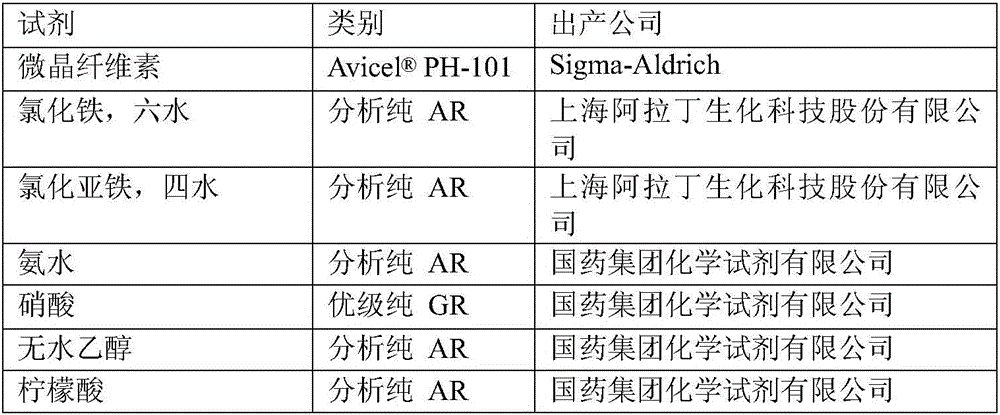Method for absorbing heavy metal in solution through carboxylic nano-crystal cellulose magnetic particles
A technology of nanocrystalline cellulose and magnetic particles, applied in chemical instruments and methods, alkali metal compounds, adsorption water/sewage treatment, etc., can solve the problems of low adsorption capacity, affecting adsorption selectivity and adsorption capacity, etc., and achieve adsorption capacity Large, low cost, regenerative effect
- Summary
- Abstract
- Description
- Claims
- Application Information
AI Technical Summary
Problems solved by technology
Method used
Image
Examples
Embodiment 1
[0026] A method for carboxylated nanocrystalline cellulose magnetic particles to absorb heavy metals in a solution, the method is to prepare nanocrystalline cellulose from microcrystalline cellulose, then prepare nanocrystalline cellulose magnetic particles through graft modification, and finally convert nanocrystalline cellulose to Su magnetic particles are wrapped in microcapsules to obtain nanocrystalline cellulose magnetic particle adsorbent, and the adsorbent is used to adsorb heavy metal ions in the solution.
[0027] The preparation method of microcrystalline cellulose to prepare nanocrystalline cellulose is: 6gMCC plus 200mL of 2mol / L ammonium persulfate solution, mix well, soak for a period of time, place in an ultrasonic 70KHz reactor, stir and react at 60°C, after the reaction To obtain a suspension, place the suspension in a high-speed centrifuge at 9000r / min for repeated centrifugation and washing to near neutrality, dissolve the prepared colloidal substance with 2...
Embodiment 2
[0032] A method for carboxylated nanocrystalline cellulose magnetic particles to absorb heavy metals in a solution, the method is to prepare nanocrystalline cellulose from microcrystalline cellulose, then prepare nanocrystalline cellulose magnetic particles through graft modification, and finally convert nanocrystalline cellulose to Su magnetic particles are wrapped in microcapsules to obtain nanocrystalline cellulose magnetic particle adsorbent, and the adsorbent is used to adsorb heavy metal ions in the solution.
[0033] The preparation method of microcrystalline cellulose to prepare nanocrystalline cellulose is: 6gMCC plus 200mL of 2mol / L ammonium persulfate solution, mix well, soak for a period of time, place in an ultrasonic 80KHz reactor, stir and react at 60°C, after the reaction To obtain a suspension, place the suspension in a high-speed centrifuge at 9000r / min for repeated centrifugation and washing to near neutrality, dissolve the prepared colloidal substance with 2...
Embodiment 3
[0038] A method for carboxylated nanocrystalline cellulose magnetic particles to absorb heavy metals in a solution, the method is to prepare nanocrystalline cellulose from microcrystalline cellulose, then prepare nanocrystalline cellulose magnetic particles through graft modification, and finally convert nanocrystalline cellulose to Su magnetic particles are wrapped in microcapsules to obtain nanocrystalline cellulose magnetic particle adsorbent, and the adsorbent is used to adsorb heavy metal ions in the solution.
[0039] The preparation method of microcrystalline cellulose to prepare nanocrystalline cellulose is: 6gMCC plus 200mL of 2mol / L ammonium persulfate solution, mix well, soak for a period of time, place in an ultrasonic 90KHz reactor, stir and react at 60°C, after the reaction To obtain a suspension, place the suspension in a high-speed centrifuge at 9000r / min for repeated centrifugation and washing to near neutrality, dissolve the prepared colloidal substance with 2...
PUM
| Property | Measurement | Unit |
|---|---|---|
| particle diameter | aaaaa | aaaaa |
Abstract
Description
Claims
Application Information
 Login to View More
Login to View More - R&D
- Intellectual Property
- Life Sciences
- Materials
- Tech Scout
- Unparalleled Data Quality
- Higher Quality Content
- 60% Fewer Hallucinations
Browse by: Latest US Patents, China's latest patents, Technical Efficacy Thesaurus, Application Domain, Technology Topic, Popular Technical Reports.
© 2025 PatSnap. All rights reserved.Legal|Privacy policy|Modern Slavery Act Transparency Statement|Sitemap|About US| Contact US: help@patsnap.com



